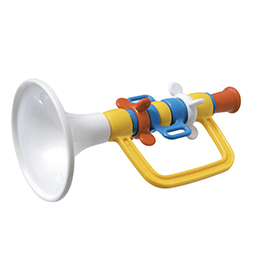
Are you familiar with the "Annual Noisy Toys List?” I wasn't until recently, and it surprised me in a couple of ways. Looking back to when my children were babies and toddlers, they received numerous toy gifts, many of which were quite noisy. I vividly remember a fire truck with an incredibly loud siren – so loud that I chose not to insert batteries for the sake of my own peace! It never occurred to me at the time to think about the potential impact of noise on my children’s hearing.
The measurement of sound is expressed in units known as decibels, denoted as dB. A faint whisper registers at approximately 30 decibels, while a typical conversation hovers around 60 decibels.
According to the Canadian Consumer Product Safety Act, a toy “must not make or emit noise of more than 100 dB when measured at the distance that the toy would ordinarily be from the ear of the child who is using it.” To put this into perspective, a noise level of 100 dB is comparable to the sound generated by a motorcycle or a lawnmower. Exposure to this level of intensity is considered safe for adults for only five to ten minutes, but the potential for damage increases even more rapidly in the sensitive ears of children.
It is not unusual for toys to be noisy enough to risk a child’s hearing health. One of the most common causes of noise-induced hearing loss is repeated exposure to loud noises over an extended period of time. Small children do not always play with toys as they are intended. When a noisy toy is brought close to the ears, the danger is even greater, as the decibel level can increase to 120dB, which is equivalent to the sound of a jet engine on take-off.
While 82 dB has been deemed safe for adults over an eight-hour period, it is advisable to use an even lower volume for children. A child’s inner ear is more sensitive to noise, making children more vulnerable to noise-related hearing loss. It is crucial to note that ears can adapt to higher volume levels over time, and children or teens may not be aware that elevated volumes can be detrimental to their hearing.
How can parents, family members, and caregivers contribute to ensuring safe toy noise levels?
Listen before you buy. Before you swipe that credit card, give the toy a listen. If it roars like a lion at arm's length, it will likely be even louder in a child's hands at close range.
Opt for adjustable volume. Be the DJ of the playroom. Choose toys with volume controls and an on/off switch to keep the sound in check.
Time limits. Set the stage for a grand performance
by limiting the time your little rockstar spends with the noisy toy.
Supervision is key. Be the sound engineer of playtime. Keep an eye on your mini maestro and keep the noisy toy at a safe distance. Double the distance to reduce the decibels! Teach children to keep the toy away from their ears and face.
Strategic measures. Try this ninja move: "forget" to put batteries in or use duct tape to cover the sound source. Everyone’s ears will thank you.
Toys that buzz, squeak, and squeal are not bad. They can still be enjoyed by children… but with hearing safety in mind.
Rosemary is the Communication & Fund Development Manager for Deaf & Hear Alberta. Their mission is to bring together Deaf, hard of hearing, and hearing Albertans with service and technology options to advance access and opportunity.
See our related articles:
Calgary’s Child Magazine © 2024 Calgary’s Child